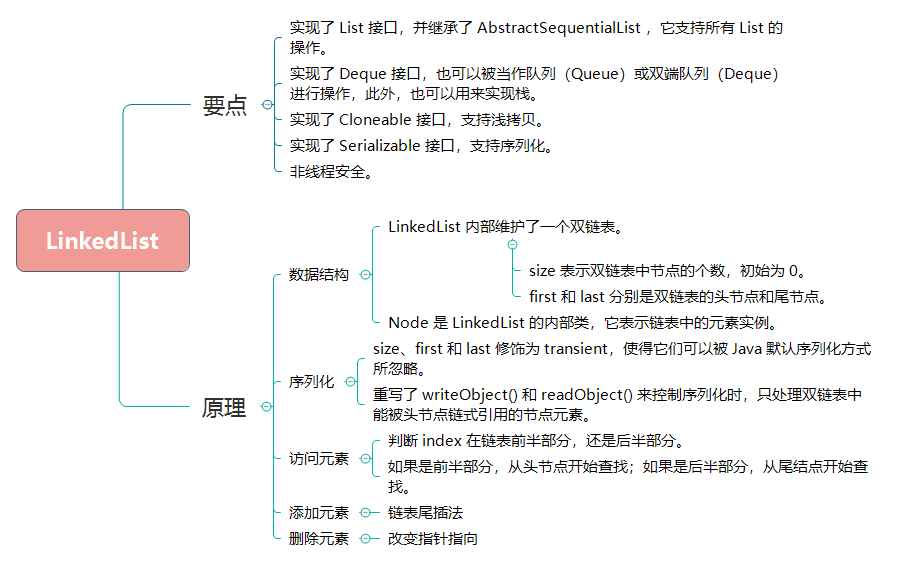Java 容器之 List
Java 容器之 List
List是Collection的子接口,其中可以保存各个重复的内容。
List 简介
List 是一个接口,它继承于 Collection 的接口。它代表着有序的队列。
AbstractList 是一个抽象类,它继承于 AbstractCollection。AbstractList 实现了 List 接口中除 size()、get(int location) 之外的函数。
AbstractSequentialList 是一个抽象类,它继承于 AbstractList。AbstractSequentialList 实现了“链表中,根据 index 索引值操作链表的全部函数”。
ArrayList 和 LinkedList
ArrayList、LinkedList 是 List 最常用的实现。
ArrayList基于动态数组实现,存在容量限制,当元素数超过最大容量时,会自动扩容;LinkedList基于双向链表实现,不存在容量限制。ArrayList随机访问速度较快,随机插入、删除速度较慢;LinkedList随机插入、删除速度较快,随机访问速度较慢。ArrayList和LinkedList都不是线程安全的。
Vector 和 Stack
Vector 和 Stack 的设计目标是作为线程安全的 List 实现,替代 ArrayList。
Vector-Vector和ArrayList类似,也实现了List接口。但是,Vector中的主要方法都是synchronized方法,即通过互斥同步方式保证操作的线程安全。Stack-Stack也是一个同步容器,它的方法也用synchronized进行了同步,它实际上是继承于Vector类。
ArrayList
ArrayList 从数据结构角度来看,可以视为支持动态扩容的线性表。

ArrayList 要点
ArrayList 是一个数组队列,相当于动态数组。**ArrayList 默认初始容量大小为 10 ,添加元素时,如果发现容量已满,会自动扩容为原始大小的 1.5 倍**。因此,应该尽量在初始化 ArrayList 时,为其指定合适的初始化容量大小,减少扩容操作产生的性能开销。
ArrayList 定义:
1 | public class ArrayList<E> extends AbstractList<E> |
从 ArrayList 的定义,不难看出 ArrayList 的一些基本特性:
ArrayList实现了List接口,并继承了AbstractList,它支持所有List的操作。ArrayList实现了RandomAccess接口,支持随机访问。RandomAccess是一个标志接口,它意味着“只要实现该接口的List类,都支持快速随机访问”。在ArrayList中,我们即可以通过元素的序号快速获取元素对象;这就是快速随机访问。ArrayList实现了Cloneable接口,默认为浅拷贝。ArrayList实现了Serializable接口,支持序列化,能通过序列化方式传输。ArrayList是非线程安全的。
ArrayList 原理
ArrayList 的数据结构
ArrayList 包含了两个重要的元素:elementData 和 size。
1 | // 默认初始化容量 |
size- 是动态数组的实际大小。elementData- 是一个Object数组,用于保存添加到ArrayList中的元素。
ArrayList 的序列化
ArrayList 具有动态扩容特性,因此保存元素的数组不一定都会被使用,那么就没必要全部进行序列化。为此,ArrayList 定制了其序列化方式。具体做法是:
- 存储元素的
Object数组(即elementData)使用transient修饰,使得它可以被 Java 序列化所忽略。 ArrayList重写了writeObject()和readObject()来控制序列化数组中有元素填充那部分内容。
:bulb: 不了解 Java 序列化方式,可以参考:Java 序列化
ArrayList 构造方法
ArrayList 类实现了三个构造函数:
- 第一个是默认构造方法,ArrayList 会创建一个空数组;
- 第二个是创建 ArrayList 对象时,传入一个初始化值;
- 第三个是传入一个集合类型进行初始化。
当 ArrayList 新增元素时,如果所存储的元素已经超过其当前容量,它会计算容量后再进行动态扩容。数组的动态扩容会导致整个数组进行一次内存复制。因此,初始化 ArrayList 时,指定数组初始大小,有助于减少数组的扩容次数,从而提高系统性能。
1 | public ArrayList() { |
ArrayList 访问元素
ArrayList 访问元素的实现主要基于以下关键性源码:
1 | // 获取第 index 个元素 |
实现非常简单,其实就是**通过数组下标访问数组元素,其时间复杂度为 O(1)**,所以很快。
ArrayList 添加元素
ArrayList 添加元素有两种方法:一种是添加元素到数组末尾,另外一种是添加元素到任意位置。
1 | // 添加元素到数组末尾 |
两种添加元素方法的不同点是:
- 添加元素到任意位置,会导致在该位置后的所有元素都需要重新排列;
- 而添加元素到数组末尾,在没有发生扩容的前提下,是不会有元素复制排序过程的。
两种添加元素方法的共同点是:添加元素时,会先检查容量大小,如果发现容量不足,会自动扩容为原始大小的 1.5 倍。
ArrayList 添加元素的实现主要基于以下关键性源码:
1 | private void ensureCapacityInternal(int minCapacity) { |
ArrayList 执行添加元素动作(add 方法)时,调用 ensureCapacityInternal 方法来保证容量足够。
- 如果容量足够时,将数据作为数组中
size+1位置上的元素写入,并将size自增 1。 - 如果容量不够时,需要使用
grow方法进行扩容数组,新容量的大小为oldCapacity + (oldCapacity >> 1),也就是旧容量的 1.5 倍。扩容操作实际上是调用Arrays.copyOf()把原数组拷贝为一个新数组,因此最好在创建ArrayList对象时就指定大概的容量大小,减少扩容操作的次数。
ArrayList 删除元素
ArrayList 的删除方法和添加元素到任意位置方法有些相似。
ArrayList 在每一次有效的删除操作后,都要进行数组的重组,并且删除的元素位置越靠前,数组重组的开销就越大。具体来说,ArrayList 会**调用 System.arraycopy() 将 index+1 后面的元素都复制到 index 位置上。
1 | public E remove(int index) { |
ArrayList 的 Fail-Fast
ArrayList 使用 modCount 来记录结构发生变化的次数。结构发生变化是指添加或者删除至少一个元素的所有操作,或者是调整内部数组的大小,仅仅只是设置元素的值不算结构发生变化。
在进行序列化或者迭代等操作时,需要比较操作前后 modCount 是否改变,如果发生改变,ArrayList 会抛出 ConcurrentModificationException。
1 | private void writeObject(java.io.ObjectOutputStream s) |
LinkedList
LinkedList 从数据结构角度来看,可以视为双链表。

LinkedList 要点
LinkedList 基于双链表结构实现。由于是双链表,所以顺序访问会非常高效,而随机访问效率比较低。
LinkedList 定义:
1 | public class LinkedList<E> |
从 LinkedList 的定义,可以得出 LinkedList 的一些基本特性:
LinkedList实现了List接口,并继承了AbstractSequentialList,它支持所有List的操作。LinkedList实现了Deque接口,也可以被当作队列(Queue)或双端队列(Deque)进行操作,此外,也可以用来实现栈。LinkedList实现了Cloneable接口,默认为浅拷贝。LinkedList实现了Serializable接口,支持序列化。LinkedList是非线程安全的。
LinkedList 原理
LinkedList 的数据结构
LinkedList 内部维护了一个双链表。
LinkedList 通过 Node 类型的头尾指针(first 和 last)来访问数据。
1 | // 链表长度 |
size- 表示双链表中节点的个数,初始为 0。first和last- 分别是双链表的头节点和尾节点。
Node 是 LinkedList 的内部类,它表示链表中的元素实例。Node 中包含三个元素:
prev是该节点的上一个节点;next是该节点的下一个节点;item是该节点所包含的值。
1 | private static class Node<E> { |
LinkedList 的序列化
LinkedList 与 ArrayList 一样也定制了自身的序列化方式。具体做法是:
- 将
size(双链表容量大小)、first和last(双链表的头尾节点)修饰为transient,使得它们可以被 Java 序列化所忽略。 - 重写了
writeObject()和readObject()来控制序列化时,只处理双链表中能被头节点链式引用的节点元素。
LinkedList 访问元素
LinkedList 访问元素的实现主要基于以下关键性源码:
1 | public E get(int index) { |
获取 LinkedList 第 index 个元素的算法是:
- 判断 index 在链表前半部分,还是后半部分。
- 如果是前半部分,从头节点开始查找;如果是后半部分,从尾结点开始查找。
LinkedList 这种访问元素的性能是 O(N) 级别的(极端情况下,扫描 N/2 个元素);相比于 ArrayList 的 O(1),显然要慢不少。
推荐使用迭代器遍历 LinkedList ,不要使用传统的 for 循环。注:foreach 语法会被编译器转换成迭代器遍历,但是它的遍历过程中不允许修改 List 长度,即不能进行增删操作。
LinkedList 添加元素
LinkedList 有多种添加元素方法:
add(E e):默认添加元素方法(插入尾部)add(int index, E element):添加元素到任意位置addFirst(E e):在头部添加元素addLast(E e):在尾部添加元素
1 | public boolean add(E e) { |
LinkedList 添加元素的实现主要基于以下关键性源码:
1 | private void linkFirst(E e) { |
算法如下:
- 将新添加的数据包装为
Node; - 如果往头部添加元素,将头指针
first指向新的Node,之前的first对象的prev指向新的Node。 - 如果是向尾部添加元素,则将尾指针
last指向新的Node,之前的last对象的next指向新的Node。
LinkedList 删除元素
LinkedList 删除元素的实现主要基于以下关键性源码:
1 | public boolean remove(Object o) { |
算法说明:
- 遍历找到要删除的元素节点,然后调用
unlink方法删除节点; unlink删除节点的方法:- 如果当前节点有前驱节点,则让前驱节点指向当前节点的下一个节点;否则,让双链表头指针指向下一个节点。
- 如果当前节点有后继节点,则让后继节点指向当前节点的前一个节点;否则,让双链表尾指针指向上一个节点。
List 常见问题
Arrays.asList 问题点
在业务开发中,我们常常会把原始的数组转换为 List 类数据结构,来继续展开各种 Stream 操作。通常,我们会使用 Arrays.asList 方法可以把数组一键转换为 List。
【示例】Arrays.asList 转换基本类型数组
1 | int[] arr = { 1, 2, 3 }; |
【输出】
1 | 11:26:33.214 [main] INFO io.github.dunwu.javacore.container.list.AsList示例 - list:[[I@ae45eb6] size:1 class:class [I |
数组元素个数为 3,但转换后的列表个数为 1。
由此可知, Arrays.asList 第一个问题点:不能直接使用 Arrays.asList 来转换基本类型数组。
其原因是:Arrays.asList 方法传入的是一个泛型 T 类型可变参数,最终 int 数组整体作为了一个对象成为了泛型类型 T:
1 | public static <T> List<T> asList(T... a) { |
直接遍历这样的 List 必然会出现 Bug,修复方式有两种,如果使用 Java8 以上版本可以使用 Arrays.stream 方法来转换,否则可以把 int 数组声明为包装类型 Integer 数组:
【示例】转换整型数组为 List 的正确方式
1 | int[] arr1 = { 1, 2, 3 }; |
【示例】Arrays.asList 转换引用类型数组
1 | String[] arr = { "1", "2", "3" }; |
抛出 java.lang.UnsupportedOperationException。
抛出异常的原因在于 Arrays.asList 第二个问题点:**Arrays.asList 返回的 List 不支持增删操作**。Arrays.asList 返回的 List 并不是我们期望的 java.util.ArrayList,而是 Arrays 的内部类 ArrayList。
查看源码,我们可以发现 Arrays.asList 返回的 ArrayList 继承了 AbstractList,但是并没有覆写 add 和 remove 方法。
1 | private static class ArrayList<E> extends AbstractList<E> |
Arrays.asList 第三个问题点:**对原始数组的修改会影响到我们获得的那个 List**。ArrayList 其实是直接使用了原始的数组。
解决方法很简单,重新 new 一个 ArrayList 初始化 Arrays.asList 返回的 List 即可:
1 | String[] arr = { "1", "2", "3" }; |
List.subList 问题点
List.subList 直接引用了原始的 List,也可以认为是共享“存储”,而且对原始 List 直接进行结构性修改会导致 SubList 出现异常。
1 | private static List<List<Integer>> data = new ArrayList<>(); |
出现 OOM 的原因是,循环中的 1000 个具有 10 万个元素的 List 始终得不到回收,因为它始终被 subList 方法返回的 List 强引用。
解决方法是:
1 | private static void oomfix() { |
【示例】子 List 强引用原始的 List
1 | private static void wrong() { |
抛出 java.util.ConcurrentModificationException。
解决方法:
一种是,不直接使用 subList 方法返回的 SubList,而是重新使用 new ArrayList,在构造方法传入 SubList,来构建一个独立的 ArrayList;
另一种是,对于 Java 8 使用 Stream 的 skip 和 limit API 来跳过流中的元素,以及限制流中元素的个数,同样可以达到 SubList 切片的目的。
1 | //方式一: |